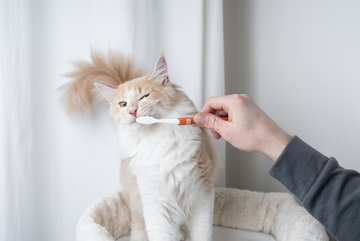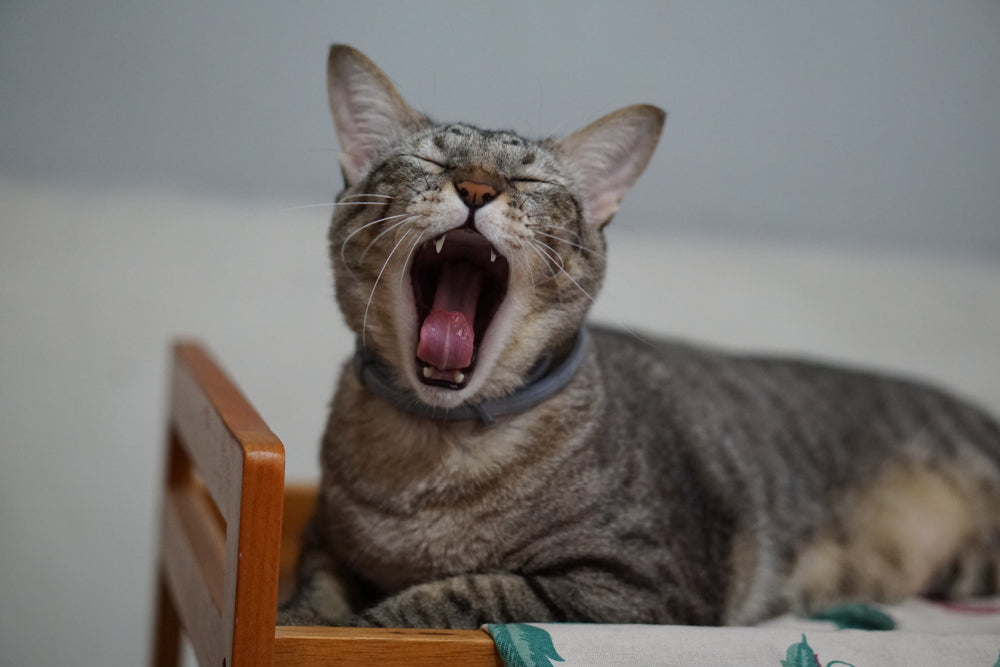9 Min Read
What Is Cat Periodontal Disease?
Key takeaway
Cat periodontal disease is a serious medical condition that affects many adult cats. The most common cause of gum disease in cats is poor oral hygiene. When left untreated, it can be life-threatening since bacteria from excess plaque can enter the bloodstream and affect kidney, heart, and liver health.

Why pet owners are switching to online vet care with Dutch
-
Prescriptions delivered free to you
-
Fast access to Licensed Vets over video
-
Unlimited video visits and follow-ups
Cat periodontal disease is an oral infection caused by plaque and bacteria buildup. The first stage of periodontal disease in animals is gingivitis, which causes inflammation due to plaque. Periodontal disease is a more severe version of gingivitis that causes inflammation of the bone and oral ligaments, causing pocketing and bone resorption that can be incredibly painful for cats.1
Unfortunately, even though periodontal disease is preventable, it affects many cats over the age of three years old due to a lack of proper oral hygiene. Left untreated, cat dental disease can spread into the tooth pocket and cause the bone to deteriorate. Bacteria can also enter the bloodstream and affect their overall health.
Cat dental care at home can prevent periodontal disease, which can cause life-threatening illnesses. In this article, we'll discuss periodontal disease in cats, symptoms, treatment, and prevention.
- Symptoms Of Periodontal Disease In Cats
- What Causes Periodontal Disease In Cats?
- Treatment & Prevention
- Cat Periodontal Disease: Frequently Asked Questions
- Final Notes

Symptoms Of Periodontal Disease In Cats
Gingivitis is the first stage of cat periodontal disease, so the first symptoms pet parents notice may be the signs of gingivitis. These include redness, swelling, and bleeding of the gums.2 Cats may also have halitosis, also known as bad breath, due to the buildup of plaque and bacteria stuck in the gums and teeth. Halitosis may also be a sign of a serious oral infection.
Gingivitis can be painful, so cats may eat less to prevent pain when chewing hard food. In extreme cases, cats may start losing teeth due to gingivitis.2
Gingivitis is the first stage of periodontal disease, but there are four stages in total, including:
Stage 1: Gingivitis
We've already briefly discussed the signs of gingivitis in cats, but during stage one, there is only gingivitis with no other signs of disease. However, if you look in your cat's mouth, you may notice a buildup of tartar and swollen or inflamed gums.
Stage 2: Early periodontitis
This stage of periodontal disease shows plaque accumulation under the gumline which can affect the teeth.

Stage 3: Moderate periodontitis
During Stage 3, cats might begin losing teeth because the gums are swollen and painful. Teeth and gums may start separating with teeth becoming more mobile or falling out completely.1
Stage 4: Advanced periodontitis
This stage is the most serious because the disease has started affecting the gums, teeth, and bone. In Stage 4, the gums recede with teeth roots exposed. The only treatment for cats with Stage 4 periodontal disease is tooth extraction.1
What Causes Periodontal Disease In Cats?
The main cause of periodontal disease in cats is poor oral hygiene, which allows plaque and bacteria to build up in the mouth and lead to gingivitis. Gingivitis occurs when the bacteria builds up enough and begins forcing the cat's body into an inflammatory response, which may consist of gum redness, inflammation, and pain.1
Ultimately, there are two types of bacteria in your cat's mouth– good bacteria and bad bacteria. When the bad bacteria get out of control due to improper oral hygiene, it can become pathogenic.1
If your cat's teeth aren't thoroughly cleaned regularly, plaque can eventually build up under the gums, causing inflammation and infections. Eventually, this plaque will become hard and turn into tartar, which is more difficult to remove from the surface of the teeth. However, poor oral hygiene isn't the only way cats can get gingivitis. Other diseases, such as feline leukemia virus (FLV), feline immunodeficiency virus (FIV), kidney disease, and diabetes, are associated with gingivitis.
Factors that may contribute to feline periodontal disease include:
- Age and health: Older cats are more likely to develop gum disease along with those with existing health problems.
- Diet: Experts agree that hard kibble can help scrape some plaque off of teeth and prevent accumulation that leads to bacteria growth.
- Breed and tooth alignment: Some cats are at a higher risk of gum disease than others.
- Home care: Ignoring your cat's dental hygiene can cause plaque and bacteria buildup. Brushing your cat's teeth regularly can help prevent gingivitis.
Once infection occurs, bacteria can enter your cat's bloodstream, causing life-threatening complications affecting the heart, liver, kidneys, and lungs.
Treatment & Prevention
Treatment of periodontal disease in cats depends on the stage of the disease. Your vet will remove the plaque on your cat's teeth that can lead to further infection. Luckily, gingivitis is reversible in most cases.1 However, periodontal disease is not. Proper care of your cat's teeth is essential to prevent a life-threatening complication due to poor oral hygiene.
Vets can reverse gingivitis by cleaning their teeth with your cat under general anesthesia.1 These cleanings can return the gums to a healthy state, but it cannot reach under the gumline to treat a more serious infection. If the gingivitis is not treated properly, it can result in a more serious illness. Additionally, if your cat has gingivitis or gum disease due to other factors like a health issue, your vet will aim to treat or manage that condition to improve their oral health.1
Later stage periodontal disease requires more aggressive treatment, involving the removal of plaque on root surfaces and smoothing the root surfaces.1 Depending on your cat's oral health, they may need to have some teeth pulled to stop the spread of the infection.
Pet parents can prevent gingivitis from turning into periodontal disease if it's still in the early stages by brushing their teeth at home on a daily basis with cat toothpaste and a toothbrush. You can also schedule dental cleanings with your vet to keep your cat's teeth clean and remove tartar that you can't with regular brushing at home.
Unfortunately, once the damage has begun, you cannot reverse periodontal disease. With procedures like deep cleaning, root canals, bone replacement, and extractions, your vet may be able to prevent periodontal disease in cats from worsening. If you don't take proper care of your cat's oral health, they may eventually need surgery.
Taking good care of your cat's oral health will prevent gum disease and help treat it. The prognosis of periodontal disease in cats depends on the stage of the disease and treatment methods, but early diagnosis is key. You can catch this disease early by inspecting your cat's mouth on a regular basis. If you notice bad breath or a buildup of plaque, schedule an appointment with your vet as soon as possible to have them examined for gingivitis or dental disease.
Cat Periodontal Disease Prevention Tips
The best way to protect your cat from gingivitis and dental disease is by taking care of their oral health at home.
Here are some tips to help you care for your cat's teeth:
- Brush their teeth daily.
- Use dental foods and treats to remove plaque and tartar.
- Visit your vet for regular dental cleanings and examinations.
- Feed them more kibble to scrape plaque off the teeth and gums
Brushing your cat's teeth is the only effective way to prevent periodontal disease, although it can't be prevented in all cases. That being said, brushing your cat's teeth can prevent the disease from worsening. Unfortunately, most cats don't enjoy having their teeth brushed, so you'll need to devote some time to train them to accept it. You can use rewards-based training to make the process easier to support good tooth health.
If your cat remains unwilling to accept having their teeth brushed, talk to your vet about a prescription diet. Prescription cat food for dental health can help cats maintain good oral health even if they resist having their teeth brushed. You can also use dental treats and water additives certified by the Veterinary Oral Health Council (VOHC) to remove plaque and tartar buildup and supplement your cat's oral health routine.
Cat Periodontal Disease: Frequently Asked Questions
Why do cats get periodontal disease?
The main cause of periodontal disease in cats is poor oral hygiene. Your cat can't brush their teeth every day like you can, so they have no effective way to remove plaque, tartar, and bacteria from their teeth and gums on a daily basis. Eventually, plaque and bacteria build up and can extend under the gum line, eventually entering the bloodstream and causing serious health concerns.
Taking proper care of your cat's teeth and gums is the best way to prevent gingivitis and periodontal disease. Brushing your cat's teeth on a regular basis will remove plaque and bacteria from their mouth to prevent buildup that can cause inflammation and painful gums.
Is periodontal disease reversible?
Periodontal disease in cats cannot be reversed, but gingivitis can be. Gingivitis is the first stage of gum disease with signs like bad breath and inflammation of the gums. By removing plaque and tartar and taking daily care of your cat's teeth, you can reverse gingivitis, ultimately preventing periodontal disease from getting worse.
Catching gum disease in the early stages can prevent it from worsening, so examine your cat's teeth regularly to ensure they have a healthy mouth. If you notice plaque buildup or bad breath, take your cat to the vet for a more thorough examination.
Is dental disease fatal in cats?
Dental disease in cats can become fatal. Inflammation in the gums can allow bacteria to enter the bloodstream, causing heart, kidney, and liver disease. If you notice any signs of gingivitis or gum disease, take your cat to the vet as soon as possible for treatment. Depending on the stage of gum disease, your vet may clean your cat's teeth or perform a tooth extraction to prevent the disease from progressing.

Final Notes
Periodontal disease in cats is a serious, potentially life-threatening disease. Fortunately, it's preventable in most cats with good oral hygiene at home. While you can have your cat's teeth cleaned by a vet yearly, plaque, tartar, and bacteria can still build up in between professional cleanings, so you will still need to take proper care of your cat's oral health at home. Regular brushing is the most effective way to reduce plaque and prevent cat periodontal disease. However, most cats are not receptive to tooth brushing. If you're unable to brush your cat's teeth at home, consult a vet who can provide you with tips for taking care of your cat's oral health.
Dutch offers telemedicine for pets to help pet parents like you learn how to better care for your pets. Whether your cat already has the beginning stages of periodontal disease or you're wondering how you can start taking better care of their teeth health at home, we've got you covered. We can provide you with product recommendations that support your cat's oral health at home and advise on how to manage dental problems when they occur.Share
References
-
Reiter, Alexander M. “Periodontal Disease in Small Animals - Digestive System.” Merck Veterinary Manual, 4 Aug. 2022, https://www.merckvetmanual.com/digestive-system/dentistry/periodontal-disease-in-small-animals?query=periodontal.
-
“Feline Dental Disease.” Cornell University College of Veterinary Medicine, 3 May 2019, https://www.vet.cornell.edu/departments-centers-and-institutes/cornell-feline-health-center/health-information/feline-health-topics/feline-dental-disease.



